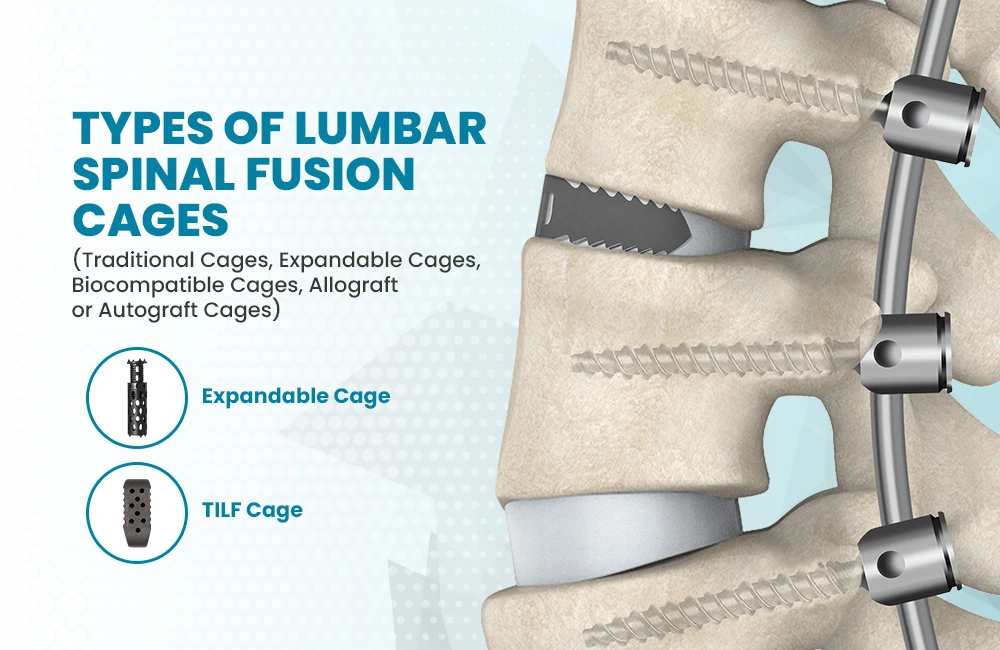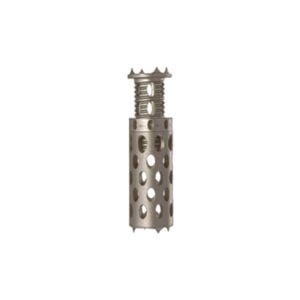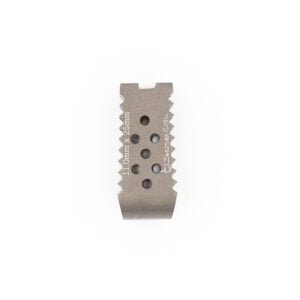Lumbar spinal fusion, a commonly performed surgical procedure, holds the promise of stabilizing the lower back and, in the process, offering respite from the often excruciating pain that plagues many. At the heart of this intricate procedure lies a critical element: lumbar spinal fusion cages. These unassuming yet indispensable spine cages are instrumental in securing the surgery’s success. In this comprehensive guide, we embark on an exploration of the profound significance, diverse types, and myriad benefits of lumbar spinal fusion cages.
The Purpose of Spinal Fusion Cages
Lumbar spinal fusion cages, also recognized as interbody cages, are meticulously engineered to introduce a much-needed element of stability to the spine while actively promoting the fusion of adjacent vertebrae.
The application of these cages extends across a broad spectrum of clinical scenarios. Whether grappling with the challenges of degenerative disc disease, herniated discs, or spondylolisthesis, these remarkable devices step up to the task with unwavering dedication. Their primary benefits of spinal cages:
Stability Enhancement: The cornerstone of lumbar fusion cages is their ability to furnish essential structural support within the spine. This pivotal role ensures the preservation of optimal spacing between vertebrae, effectively curbing undesirable movements and fortifying the core of spinal stability.
Fusion Promotion: Lumbar spinal fusion cages usher in a transformative environment that is conducive to the fusion process. This environment acts as a nurturing bed for bone grafts, encouraging their growth and the eventual union of adjacent vertebrae. The result? The elimination of painful motion and the redressal of a multitude of spinal conditions that can prove debilitating to those afflicted.
Types of Lumbar Spinal Fusion Cages

Within the domain of lumbar spinal fusion cages, there exist several types, each tailored to specific clinical scenarios and patient needs. Let’s explore these diverse categories:
Traditional Cages:
These lumbar spinal fusion cages represent the tried-and-true approach to spinal fusion. Crafted from materials like medical-grade titanium or PEEK (polyether ether ketone), traditional cages come in an assortment of shapes and sizes. Their primary function is to provide mechanical support, encourage fusion, and maintain spinal stability. The versatility of traditional spine cages makes them suitable for various spinal conditions, including degenerative disc disease and spondylolisthesis.
Expandable Cages:
 In the ever-evolving landscape of spine surgery, expandable cages have made their mark. These innovative devices offer a level of customization that traditional cages cannot match. During surgery, they can be adjusted in size, allowing surgeons to precisely tailor the implant to the patient’s unique anatomy. This adaptability proves particularly advantageous in minimally invasive procedures, where minimizing tissue disruption and optimizing fit are paramount.
In the ever-evolving landscape of spine surgery, expandable cages have made their mark. These innovative devices offer a level of customization that traditional cages cannot match. During surgery, they can be adjusted in size, allowing surgeons to precisely tailor the implant to the patient’s unique anatomy. This adaptability proves particularly advantageous in minimally invasive procedures, where minimizing tissue disruption and optimizing fit are paramount.
Biocompatible Cages:
Biocompatible lumbar spinal fusion cages are designed with materials that not only offer structural support but also ensure minimal risk of adverse reactions or complications within the patient’s body. These cages, often constructed from materials like titanium or PEEK, provide stability and foster fusion while minimizing the chances of allergic responses or rejections.
Allograft or Autograft Cages:
These specialized lumbar spinal fusion cages are designed to accommodate bone graft material. Surgeons may opt to use either an allograft (donor bone) or an autograft (the patient’s own bone) to promote fusion. These spine cages securely house the graft material, providing a conducive environment for the graft to integrate with the patient’s bone, ultimately achieving spinal stability.
Lumbar Spinal Fusion Cages by Zealmax Ortho
Expandable Cage with Plate:
 The Expandable Cage with Plate represents a cutting-edge solution for modern vertebral body reconstruction in surgical procedures. Once the vertebrae are removed, this cage is inserted and expanded, offering robust fixation while providing added support within the vertebral endplate. It also ensures ample space for bone graft placement.
The Expandable Cage with Plate represents a cutting-edge solution for modern vertebral body reconstruction in surgical procedures. Once the vertebrae are removed, this cage is inserted and expanded, offering robust fixation while providing added support within the vertebral endplate. It also ensures ample space for bone graft placement.
Specifications of this innovative system include a focus on minimally invasive procedures, as it simplifies insertion and quick positioning. Its dimensional accuracy guarantees dependable performance, optimizing the anatomical fit through an anterior cervical approach. Furthermore, it effectively distributes loads between the implant and vertebrae, enabling continuous expansion to the desired height. Notably, it maintains implant height stability without the need for additional steps. This system is available in Titanium material, further enhancing its reliability and suitability for surgical applications.
PLIF Bullet Type Cage:
 Our spinal cord is prone to injuries due to various reasons such as damage to the vertebrae, ligaments, or discs of the spinal column or to the spinal cord itself, a traumatic blow that fractures, dislocates, crushes, or compresses one or more vertebras, or disorders such as degenerative disc disease, scoliosis, spondylolisthesis, etc. Thus, to help such injured spines stay intact or get back on track, spinal implants are necessary and the PLIF cage is one among them.
Our spinal cord is prone to injuries due to various reasons such as damage to the vertebrae, ligaments, or discs of the spinal column or to the spinal cord itself, a traumatic blow that fractures, dislocates, crushes, or compresses one or more vertebras, or disorders such as degenerative disc disease, scoliosis, spondylolisthesis, etc. Thus, to help such injured spines stay intact or get back on track, spinal implants are necessary and the PLIF cage is one among them.
Used majorly to treat lumbar degenerative disc disease, insertion of PLIF cage helps in fusing the painful vertebral segments in order to stop the painful motion. Made of Titanium grade 5 and PEEK material, our PLIF Bullet Type Cage is available in various lengths and sizes so as to help surgeons find the best fit for their patients.
TLIF Cage:
 Meticulously engineered to replicate anatomical structure, the Transforaminal Lumbar Interbody Fusion (TLIF) cage creates optimal fusion conditions. It effectively replaces lumbar intervertebral discs, fusing adjacent vertebral bodies from levels L1 to S1. This TLIF implant, designed for insertion through a transforaminal approach, enhances precision and success in spinal procedures.
Meticulously engineered to replicate anatomical structure, the Transforaminal Lumbar Interbody Fusion (TLIF) cage creates optimal fusion conditions. It effectively replaces lumbar intervertebral discs, fusing adjacent vertebral bodies from levels L1 to S1. This TLIF implant, designed for insertion through a transforaminal approach, enhances precision and success in spinal procedures.
Key specifications of the TLIF cage include its ability to facilitate fusion through the cage, promoting swift and direct osseointegration. Insertion is simplified thanks to its anatomical shape, available in various widths and heights to cater to individual patient needs. Postoperative assessment is made easier with clear and precise visual evaluation through imaging methods like X-rays, CT scans, and MRI. Furthermore, it proves valuable for maintaining intervertebral height in the lumbar region, thanks to its thoughtful design, which features a bullet nose for self-distraction during insertion. The surface’s self-guiding rails ensure accurate guidance and placement, enhancing the overall effectiveness of the cage in spinal fusion procedures.
Benefits of Lumbar Spinal Fusion Cages
Pain Relief: The fusion process, facilitated by these cages, eliminates the source of pain in conditions like degenerative disc disease or herniated discs.
Improved Stability: Cages enhance spinal stability, reducing the risk of further degeneration and deformity.
Minimally Invasive Options: Some cages are designed for minimally invasive surgery, reducing tissue disruption, postoperative pain, and recovery time.
Customization: Expandable cages allow for a personalized fit, improving the likelihood of a successful fusion.
Conclusion
Zealmax Ortho’s lumbar spinal fusion cages, designed with precision and excellence, revolutionize spine surgery by providing surgeons with versatile, technology-driven tools. These cages prioritize precision, alignment, and simplicity in surgical procedures, marking a significant advancement in spinal healthcare and underscoring Zealmax Ortho’s commitment to progress in spine surgery as a leading Spine Implants manufacturer.

